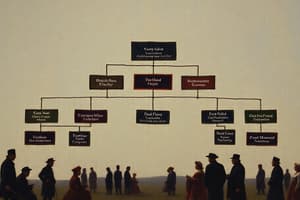Podcast
Questions and Answers
What does a marketing structure define?
What does a marketing structure define?
A marketing structure defines the way a company organizes its marketing efforts, outlining roles, responsibilities, and reporting lines within the marketing department.
What are the three key factors to consider when choosing the right marketing structure?
What are the three key factors to consider when choosing the right marketing structure?
The three key factors are the company's size, goals, and resources.
In a functional marketing structure, team members are organized by:
In a functional marketing structure, team members are organized by:
- customer segment
- geographic location
- marketing function (correct)
- specific products or services
How are marketing teams organized in a product/service structure?
How are marketing teams organized in a product/service structure?
What is the defining characteristic of a geographic marketing structure?
What is the defining characteristic of a geographic marketing structure?
How are teams arranged in a customer structure?
How are teams arranged in a customer structure?
Describe the matrix marketing structure.
Describe the matrix marketing structure.
Which type of marketing structure is typically employed by smaller companies?
Which type of marketing structure is typically employed by smaller companies?
When a company is expanding geographically, which marketing structure might be most appropriate?
When a company is expanding geographically, which marketing structure might be most appropriate?
What is the connection between a marketing structure and available resources?
What is the connection between a marketing structure and available resources?
Perfect competition represents an ideal scenario for both buyers and sellers.
Perfect competition represents an ideal scenario for both buyers and sellers.
List the five characteristics of a perfectly competitive market.
List the five characteristics of a perfectly competitive market.
What does a homogeneous product imply in a perfectly competitive market?
What does a homogeneous product imply in a perfectly competitive market?
What is meant by perfect mobility of resources in a perfectly competitive market?
What is meant by perfect mobility of resources in a perfectly competitive market?
In a perfectly competitive market, individual firms have a significant impact on market price.
In a perfectly competitive market, individual firms have a significant impact on market price.
How is the market price determined in a perfectly competitive market?
How is the market price determined in a perfectly competitive market?
In a pure competition market, firms can differentiate their products to gain a competitive advantage.
In a pure competition market, firms can differentiate their products to gain a competitive advantage.
What is the key characteristic of a pure competition market in terms of the number of buyers and sellers?
What is the key characteristic of a pure competition market in terms of the number of buyers and sellers?
In a pure competition market, firms can easily enter or exit the market without facing major obstacles.
In a pure competition market, firms can easily enter or exit the market without facing major obstacles.
In pure competition, all products sold in the market are identical, or at least similar.
In pure competition, all products sold in the market are identical, or at least similar.
What does "perfect information" refer to in a pure competition market?
What does "perfect information" refer to in a pure competition market?
In a pure competition market, firms are considered:
In a pure competition market, firms are considered:
In a pure competition market, there are barriers to entry for new firms.
In a pure competition market, there are barriers to entry for new firms.
What is the main reason for the ease of entry and exit for firms in a pure competition market?
What is the main reason for the ease of entry and exit for firms in a pure competition market?
How does perfect competition affect market behavior?
How does perfect competition affect market behavior?
In a perfectly competitive market, firms prioritize maximizing profits.
In a perfectly competitive market, firms prioritize maximizing profits.
Perfect competition always leads to firms minimizing costs.
Perfect competition always leads to firms minimizing costs.
Firms in a perfectly competitive market always innovate and improve their products to reduce costs.
Firms in a perfectly competitive market always innovate and improve their products to reduce costs.
In a perfect competition market, what kind of advertising do firms focus on?
In a perfect competition market, what kind of advertising do firms focus on?
Perfect competition leads to long-run effects on the market.
Perfect competition leads to long-run effects on the market.
What happens to the number of firms, market supply, and price of goods in the long run when there's profit being earned in a perfectly competitive market?
What happens to the number of firms, market supply, and price of goods in the long run when there's profit being earned in a perfectly competitive market?
In an imperfectly competitive market, firms have no market power.
In an imperfectly competitive market, firms have no market power.
What distinguishes an imperfectly competitive market from a perfectly competitive market?
What distinguishes an imperfectly competitive market from a perfectly competitive market?
Which of these is NOT a characteristic of an imperfectly competitive market?
Which of these is NOT a characteristic of an imperfectly competitive market?
How do firms in an imperfectly competitive market gain market power?
How do firms in an imperfectly competitive market gain market power?
Entry and exit for firms are easier in imperfectly competitive markets than in perfectly competitive markets.
Entry and exit for firms are easier in imperfectly competitive markets than in perfectly competitive markets.
Which factors act as barriers to entry for firms in imperfectly competitive markets?
Which factors act as barriers to entry for firms in imperfectly competitive markets?
Perfect competition is a more realistic market structure than imperfect competition.
Perfect competition is a more realistic market structure than imperfect competition.
Why are perfectly competitive markets not often found in the real world?
Why are perfectly competitive markets not often found in the real world?
Understanding different market structures can help businesses strategize effectively.
Understanding different market structures can help businesses strategize effectively.
Flashcards
Functional Structure
Functional Structure
Marketing teams organized by marketing function (e.g., marketing communications, product marketing).
Marketing Structure
Marketing Structure
How a company organizes its marketing efforts, outlining roles, responsibilities, and reporting lines within the marketing department.
Geographic Structure
Geographic Structure
Marketing teams organized by geographic region.
Product/Service Structure
Product/Service Structure
Signup and view all the flashcards
Customer Structure
Customer Structure
Signup and view all the flashcards
Matrix Structure
Matrix Structure
Signup and view all the flashcards
Perfect Competition
Perfect Competition
Signup and view all the flashcards
Homogeneous Product
Homogeneous Product
Signup and view all the flashcards
Perfect Mobility of Resources
Perfect Mobility of Resources
Signup and view all the flashcards
Perfect Knowledge
Perfect Knowledge
Signup and view all the flashcards
Price Takers
Price Takers
Signup and view all the flashcards
Pure Competition
Pure Competition
Signup and view all the flashcards
Barriers to Entry
Barriers to Entry
Signup and view all the flashcards
Imperfect Competition
Imperfect Competition
Signup and view all the flashcards
Product Differentiation
Product Differentiation
Signup and view all the flashcards
Profit Maximization
Profit Maximization
Signup and view all the flashcards
Cost Minimization
Cost Minimization
Signup and view all the flashcards
Innovation
Innovation
Signup and view all the flashcards
Informative Advertising
Informative Advertising
Signup and view all the flashcards
Long Run Effects
Long Run Effects
Signup and view all the flashcards
Study Notes
Marketing Structure
- A marketing structure defines how a company organizes its marketing efforts
- It outlines roles, responsibilities, and reporting lines within the marketing department
- Choosing the right structure depends on the company's size, goals, and resources
Types of Marketing Structures
- 1. Functional Structure: Teams are organized by marketing function, such as marketing communication, product marketing, digital marketing, etc.
- 2. Product/Service Structure: Teams are organized around specific products or services
- 3. Geographic Structure: Teams are organized by geographic region
- 4. Customer Structure: Teams are organized by customer segment
- 5. Matrix Structure: A combination of two or more structures, such as functional and product/service
Choosing the Right Structure
- Company Size: Smaller companies may use a functional structure, while larger companies may use a matrix or product/service structure
- Goals: If a company focuses on launching new products, a product/service structure might be more appropriate. If expanding geographically, a geographic structure might be suitable.
- Resources: The structure should align with available resources (personnel and budget)
Market Structure
- Main classifications: Perfect Competition, Imperfect Competition
- Perfect Competition: Ideal situation for buyers and sellers
- Many buyers and sellers, each having a negligible impact on market price
- Homogenous product; goods offered for sale are exactly the same or perfectly standardized
- Perfect mobility of resources; easy transfer of resources
- Perfect knowledge of economic agents of market conditions (present and future prices, costs, and economic opportunities)
- Market price and quantity of output are exclusively determined by the forces of demand and supply
- Characteristics include:
- Large number of buyers and sellers
- Homogenous products
- Freedom of entry and exit
- Perfect information
- Price takers
- No barriers to competition
- Imperfect Competition: There are one or fewer firms compared to a perfectly competitive market; firms have some market power, influencing the price
- Characteristics include:
- Few sellers
- Product differentiation
- Barriers to entry
- Characteristics include:
- Long-run effects of Perfect Competition:
- Profit earned, attracting new firms
- Increased number of firms, leading to higher market supply
- Increased market supply leads to a decrease in the price of goods
Studying That Suits You
Use AI to generate personalized quizzes and flashcards to suit your learning preferences.




